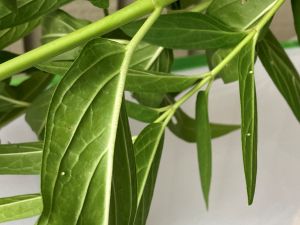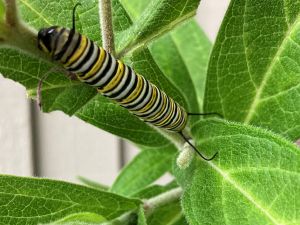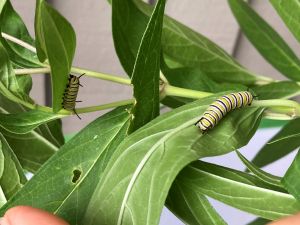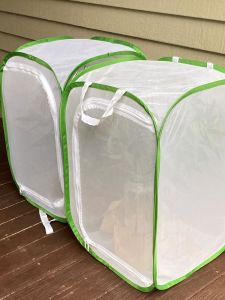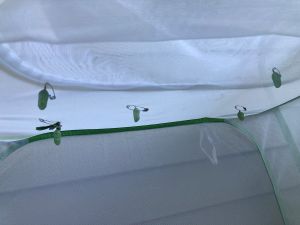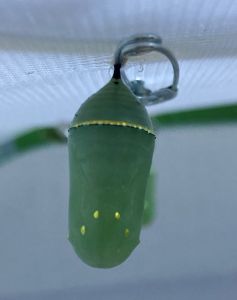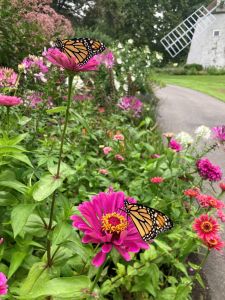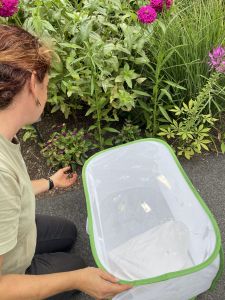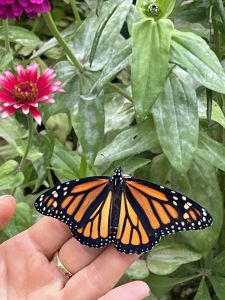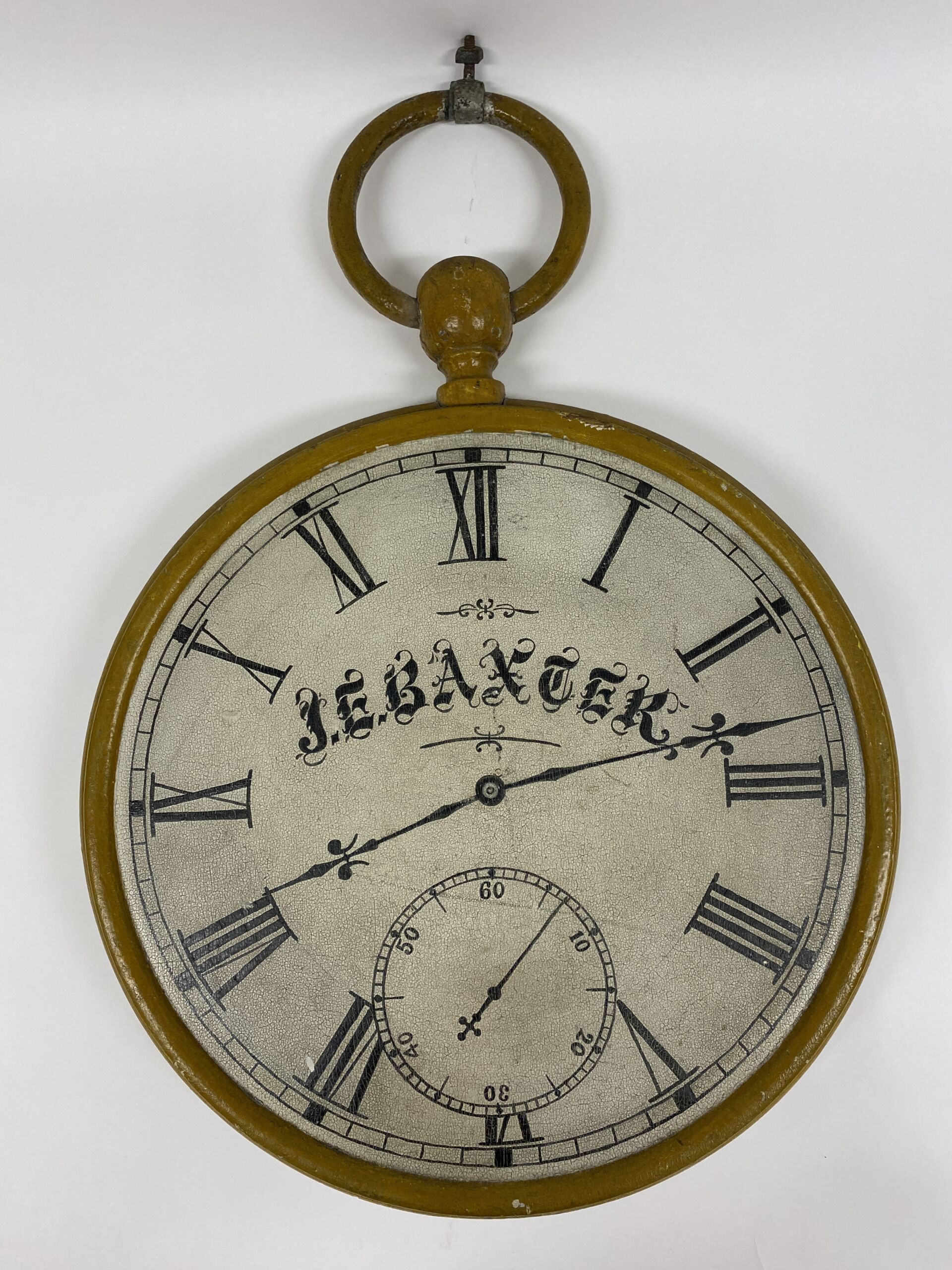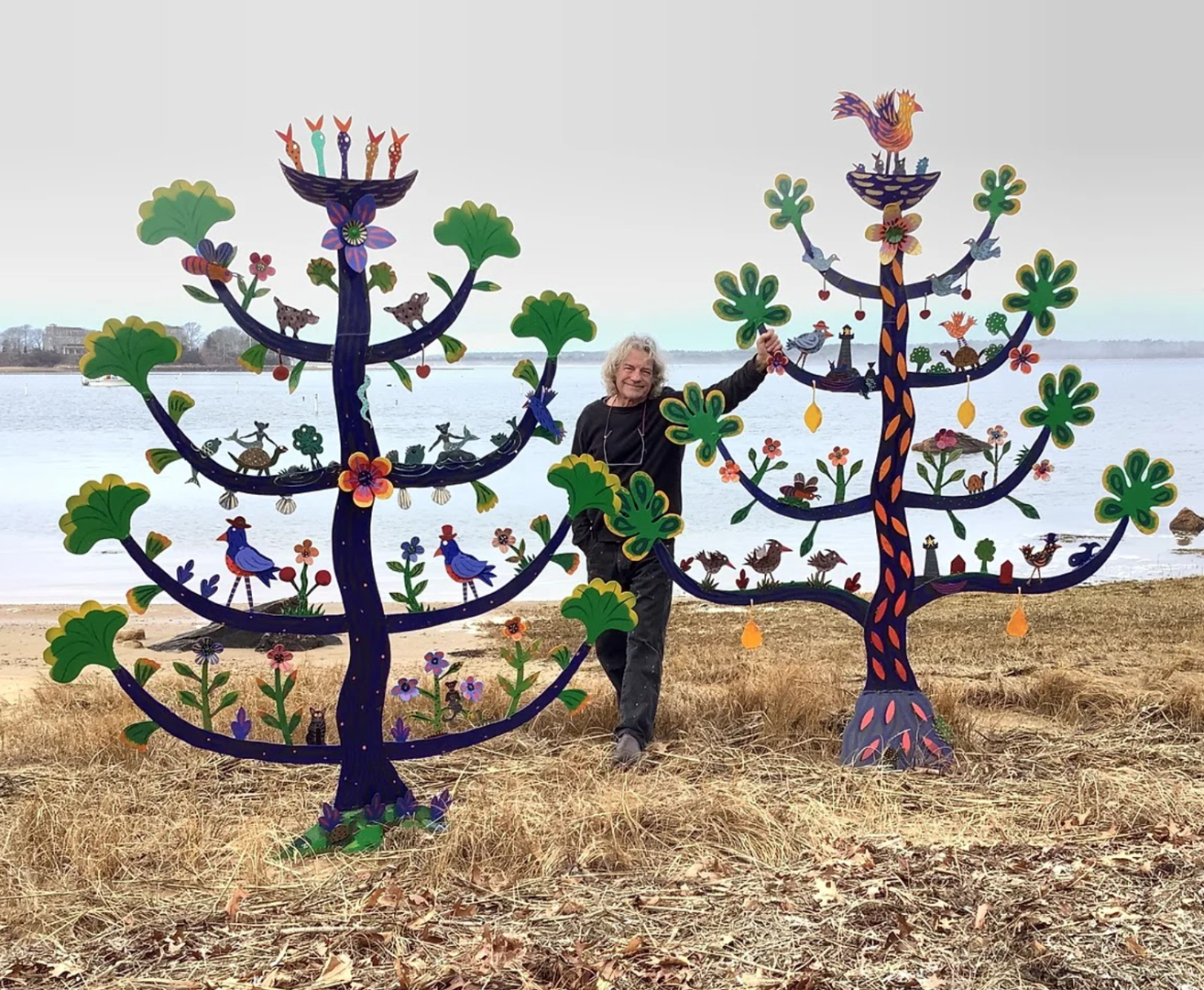Monarch Butterflies
Monarch Butterflies Need Our Help!
Tips on how to support these iconic creatures
By: Iris Clearwater, Senior Gardener
When I was a child learning how to draw or color a butterfly, I would automatically draw a monarch. These were the most common and iconic butterflies of my childhood. I remember concentrating while adding distinctive black lines amidst the orange, do you?
To me, monarchs embody the miracle of transformation! The striking, striped yellow, white, and black caterpillars transform leaves filled with bitter latex into a sea green and shimmering gold chrysalis. Inside the chrysalis, the caterpillar turns itself into liquid to reform itself completely and emerge as a radiant orange butterfly. This butterfly then travels in fall all the way to southern Mexico and miraculously, in several generations, back again.
Sadly, this year, monarchs have been listed as an endangered species with the International Union for Conservation of Nature (IUCN). This once ubiquitous creature is now in danger of becoming a fairy tale. In honor of our pollinator-themed Fourth Friday Food Truck Night on August 26th, let’s see what we can do to help keep them here!
The first thing to do is to become conscious of insecticide use. Learn about any insecticides you are applying to your lawns or plants and find out if they affect lepidoptera (butterflies and moths), native bees, or wasps. In particular, avoid pesticides with “neonicotinoids,” or “neonics” listed in the ingredients.
Also find out if any treatments to trees or shrubs are systemic – meaning they become infused into every part of the plant (pollen, sap, leaves, bark, roots, etc.) and last for months or years. Many people don’t realize that various pollinators, including butterflies and even birds, often drink the sap of trees, or that a treatment for a damaging moth will also affect all kinds of butterflies and moths.
Be sure to find out if any of the plants you purchase at nurseries have been treated with systemic insecticides. Insecticides and herbicides can also make their way into manure, hay, and compost, so you should also look into what has gone into any other gardening products that you use.
A great way we can help monarchs and other butterflies at home is by planting their host plants in clusters of at least 3 plants, and preferably in even larger groups. This helps the pollinators to find these plants and it makes the calories burned to get there worthwhile.
The first step is to find out what butterflies are local to your area, then what their host plants are (i.e. what their caterpillars feed on), and then check to see if if you have the right conditions (moisture, temperature, & light requirements) for that plant to thrive where you live. At Heritage, you can learn about our Cape Cod butterflies, their caterpillars, and host plants by visiting the McInnes Garden, located near the flagpole and wetu. You can also visit the McInnes Garden webpage anytime for all sorts of information about pollinators.
For our beautiful monarchs, their host plants are anything in the milkweed family. While monarchs feed on every kind of milkweed, not every kind of milkweed is best for your garden. Common milkweed, Asclepias syriaca, which most people think of first when imagining milkweed, is NOT good for most gardens as it spreads aggressively through rhizomes and is nearly impossible to eradicate once established. It does great in a huge naturalized meadow where it is meant to create drifts throughout.
The best choices for our gardens, and actually preferred by monarchs for breeding, are swamp milkweed, Asclepias incarnata, and butterfly weed, Asclepias tuberosa. Both of these are native to New England, provide nectar for adult butterflies, and can handle all kinds of soil and weather – though swamp milkweed is better in moist soils and butterfly weed is better for drier soils. Both can be grown fairly easily from seed, and are perennials that come back effortlessly year after year for several years.
Swamp milkweed has lovely pink flowers and grows in clusters 3-5’ tall. The subspecies, Asclepias incarnata var. pulchra, has fuzzier leaves and stems and only grows 2-3’ tall. This plant is particularly great for smaller garden beds and can handle partial shade.
Butterfly weed, Asclepias tuberosa, is always a tidy, low-growing plant of 2-3,’ with small, shiny dark green leaves and bright orange flowers the same color as monarchs! There is a cultivar ‘Hello Yellow’ that can also be grown from seed with sunny yellow flowers. Note that all milkweeds attract orange milkweed aphids late in the season, especially at the tips where the seedpods start to develop. You can keep an eye out for them and crush them before they get established, but don’t worry, it’s natural and your plants will come back just fine next year.
The adult butterflies coming to lay eggs on your host plants will also need to drink nectar for energy. The nectar plants I’ve seen them use most are coneflower, Echinacea purpurea; native purple zinnias, especially the Benary giant varieties; tall verbena, Verbena bonariensis; gayfeather or blazing Star, Liatris spp., and New England blazing star, Liatris novae-angliae a rare plant that you can help by growing in your garden.
Adult butterflies also love Phlox ‘Jeana,’ a cultivar of native phlox with some of the most abundant nectar of all phlox! If you have the space and some stakes for support, the long flowering Mexican sunflower, Tithonia rotundifolia, is a good choice to plant. With vivid orange petals and yellow centers, this flower is sure to bring butterflies and all kinds of pollinators to your garden, including the American goldfinch and song sparrows which will come for the sunflower’s seeds in late summer.
Fall blooming asters, such as the New England aster ‘Purple Dome,’ Symphyotrichum novae-angliae, as well as non-aggressive goldenrod, such as the large, showy cultivar, Solidago rugosa ‘Fireworks,’ or the small, native downy goldenrod, Solidago puberula, are great for providing nectar for our traveling friends late in the season when little else is in bloom.
Another fun and interactive way to directly help the monarch population is to raise them at home! With tons of predators from spiders, wasps, birds, and even fungi that are all part of a healthy ecosystem, it’s rare for a caterpillar to make it all the way through to become a butterfly. You can help out by bringing the plants with eggs and caterpillars into a mesh butterfly habitat.
Once you have your host and nectar plants in your garden and you start seeing monarchs visit them, you can inspect the leaves, above and below, for a little white protuberance, which is what a monarch egg looks like (see photo). You might also look for any holes in the leaves – a good indicator of caterpillar activity. Monarch caterpillars start out as miniscule versions of their future, larger selves.
If you find a host plant with a monarch egg, collect the stems of the plant and put them into a jar of water, piercing them through a cover of saran wrap held in place with a rubber band. I like to use Floralife flower food in the water, as I find it really keeps the milkweeds fresh for longer, which is important for the eggs to have the time needed to develop. I also put a sheet of parchment paper at the bottom of the habitat to collect any frass.
Like ay pets, you need to clean up after your caterpillars, feed, and water them. Feed them with additional milkweed – another reason to grow lots of milkweed in your garden – and water them by spraying the plants with a spray bottle of filtered water. In my own gardens, I cut my Asclepias incarnata, leaving at least 6 leaves at the base, and the plant will often resprout there and continue to grow, allowing me to continue to harvest food for the caterpillars.
Once a chrysalis has formed, I often wait a day or two for it to harden well, then carefully remove it by putting a safety pin through the silk webbing, wrap the remaining webbing around the pin, and fasten it to the ceiling of another habitat. If you have a lot of them, like I do, you can place the habitat horizontally for more ceiling space. Always weigh down your habitats with a nice heavy rock. I keep mine in the shade during hot weather, and in the sun in cool weather.
It takes about 1 week for the eggs to hatch, about 2 weeks for the caterpillars to grow and form a chrysalis, then another 10-14 days for the butterfly to emerge. All together, it takes about a month, with some variability, to completely go from egg to butterfly. Note that monarchs develop faster with warmth and slower with cooler temperatures. Last year I kept having eggs on the milkweed I cut to replace the ones in their habitats and ended up raising and releasing 80 monarchs!
This year I am only growing native varieties of milkweeds so that I am not releasing them too late in the season, and expect to have a smaller, but hopefully more sustainable, population. It is a wonderful feeling to be directly involved in supporting the continuation of this beautiful creature in the world, and I hope you will help in whatever way that you can.
If you don’t have a green thumb, in addition to renewing your membership to Heritage, you can also help by contributing to the Xerces society, the IUCN, or the Nature Conservancy – all of whom are doing important work to preserve pollinators. And please come often, with children, friends, and loved ones, to stroll through Heritage and to see and love the wide variety of butterflies and pollinators that our plantings, and your visits, help to support!
